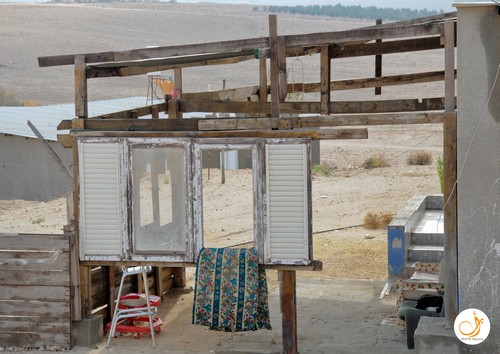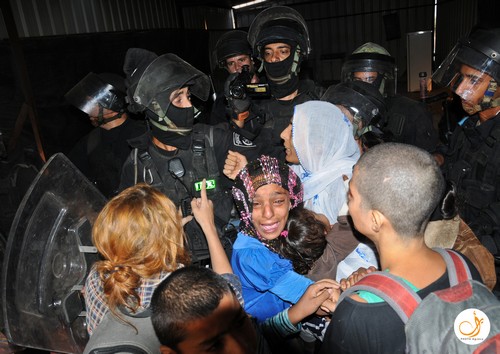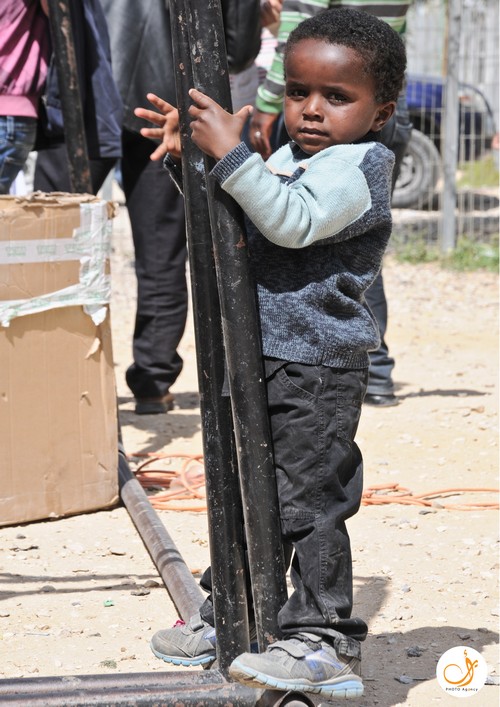Opening on Sunday, July 28, 7pm at Zochrot's Visual Research Laboratory: 34 Yitzhak Sadeh Tel Aviv, 4th floor. room 400.
Baqon documents people in the Negev who insist on clinging to their ancestral land. It was exhibited first in the "unrecognized" village of al-Araqib in 2013, and became part of the struggle against its recurring destruction by Israeli authorities. The photos illustrate the people's difficulties in the face of state violence and expulsion plans.
The exhibit's open from Sunday to Thursday 10:00 - 16:00. Please call to make sure: 03-6953155
To facebook event
I’m one of them
Aiob Abo Madegam speaks with Eitan Bronstein Aparicio about Baqon (Remaining), an exhibit of photographs
Eitan: Tell me about the photographs. Where and when are they from?
Aiob: They’re all from the Negev, from unrecognized localities. They document demolitions, demonstrations, life in the Negev. The photos in the exhibit were taken on July 27, 2010, the day Araqib was demolished for the first time. The photographs were first exhibited in Araqib in 2012; they became part of the struggle to remain there. The large demonstrations that were held show that the population organized and came together during that period. Everyone participated, women, children and men.
Eitan: But the photos aren’t only from Araqib?
Aiob: Right, there are also photos of other locations.
Eitan: Tell us something about the photographs.
Aiob: This one shows Sheikh Si’ah, one of the people most closely identified with Araqib. He’s my mother’s uncle. The photo shows an old man’s hands holding a string of prayer beads; “Mohammad” is written on one of them. Another photo shows that old man’s face. On Land Day a large demonstration was held in Wadi Alna’am; this photo shows children next to the demonstration, outside the fram, resting on the rubble of one of the buildings. During the demonstration in Beersheba I photographed only portraits, to show the participants.
Eitan: I see some photographs of the rubble/demolitions in Araqib.
Aiob: Right. This photo shows a boy, half-smiling, carrying his birds in a box. The police officer behind him is in charge of the demolition. In another photo you see a mother and daughter struggling with the policemen; two women who came to support them are helping. All the men had already been evacuated; the photo shows the forcible evacuation of the women.
Eitan: Some of the photos show various cultural activities.
Aiob: Yes, it’s important to me to show Bedouin culture to people who aren’t familiar with it. Here they’re making coffee. This implement is called a “sabab;” they pour the brewed coffee into it for serving. Another photograph was taken on a Bedouin Culture Day for children with handicaps. You see a young girl and a Bedouin woman working a “tatriz” together – a Bedouin embroidery.
Eitan: So you’re an activist photographer?
Aiob: You could say that. When the first demolitions occurred they called me at 11 PM and told me to come quickly because Araqib was being destroyed. My parents didn’t want me to go; they were afraid something bad would happen to me. I spoke to my older brother, who convinced them to agree. When I arrived I was surprised to discover that the demolition crews hadn’t come yet. We went to sleep there. There were about 150 of us, from both Israel and from abroad, who’d come in solidarity. Toward morning we received a phone call announcing that the Lahavim junction had been blocked and that forces were mobilizing at a gas station in Beersheba. The entire route from the main road to Araqib was closed down. There were about 1200 soldiers and police officers. I’ll never forget how they stood in a line facing us; the commander you see in this photograph said over his loudspeaker: Either you leave peacefully or we’ll use force. One photograph shows Sheikh Si’ah standing opposite the security forces, pointing his finger accusingly at the destruction they caused.
Eitan: Do you live in an unrecognized locality?
Aiob: No, I live in Rahat.
Eitan: So what’s your connection to this struggle?
Aiob: First of all, I have family in Araqib. I live in the Negev; I’m afraid the demolitions will reach Rahat. There have already been demolitions there. I see people who’ve come in solidarity and been beaten. They also could have said, “Why should I care? What business is it of mine? Why should I be beaten?” That’s my reality; I’m one of them. Now the Prawer plan wants to move people to recognized localities and give them a little more money. The inhabitants don’t agree. If that happens, for the rest of our lives we’ll be mankubin, people who’ve suffered a Nakba.
Eitan: What made you begin taking photographs?
Aioob: I studied photography at Sapir College, and learned more on my own. When I began photographing, it wasn’t an obvious decision. People wondered what I was doing, why I was involved in art. Later they saw it helped and today there are more photographers and I’m happy to assist them. I’m a photographer who comes from the community; I know what is permissible to photograph and what’s forbidden. When I photograph a woman I don’t show her face. Usually it’s a problem, but they know me and grant me permission. They know I do so for the good of the Bedouin population.
The conversation took place at Zochrot on Friday, 12 July 2013.

באקון (נשארים) / Baqon (Remaining)

באקון (נשארים) / Baqon (Remaining)

באקון (נשארים) / Baqon (Remaining)


